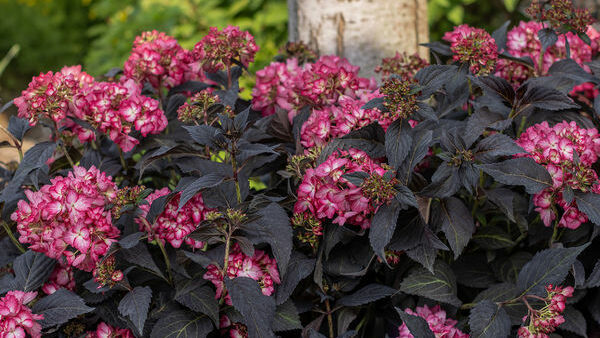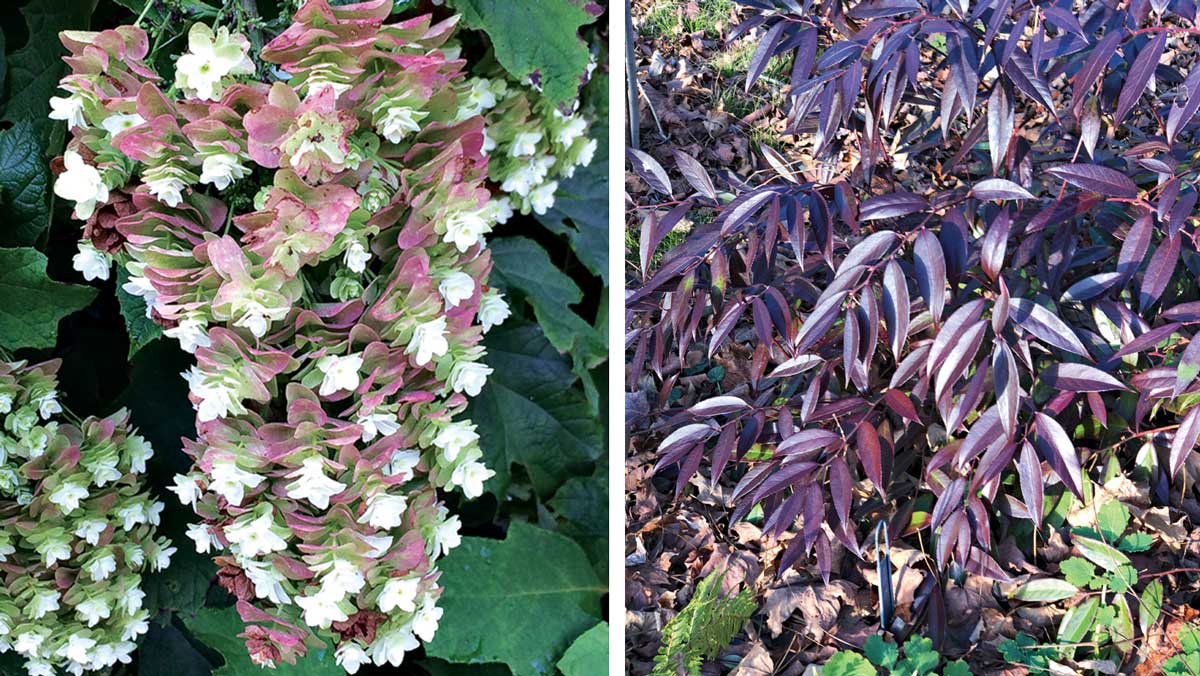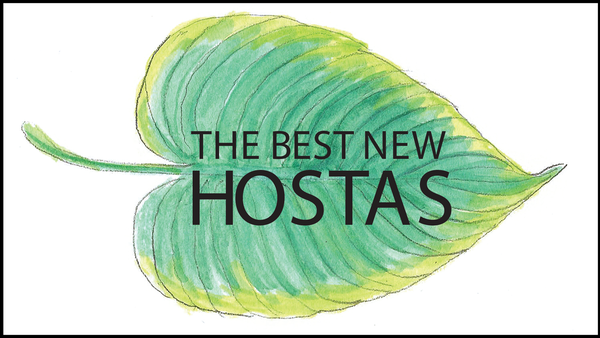
Yellowish blooms make it unique
Name: ‘French Vanilla’ hibiscus (Hibiscus ‘French Vanilla’)

Zones: 4–9
Size: 3 to 4 feet tall and wide
Conditions: Full sun; moist, well-drained soil
Native range: Hybrid
Hibiscus recently have become the new heucheras: There’s a plethora introduced annually, but none of them are very noteworthy. The exception may be this year’s ‘French Vanilla’, which sports giant pale yellow blooms. There have been supposed “yellow” varieties in the past, but most appear white. This cultivar has a definite frozen-custard hue, and according to the breeder, it holds that color for a long time. A red eye is a nice addition to the 8-inch-wide blooms.
Introduced by Proven Winners® and Walters Gardens

24-karat perfection, thanks to a novel foliage color (Editor’s choice)
Name: ‘IndiGold’ baptisia (Baptisia ‘IndiGold’)
Zones: 4–9
Size: 3 to 4 feet tall and wide
Conditions: Full sun; well-drained soil
Native range: Garden origin
Some new plants make you sit up and say, “I have never seen anything like this before.” Such was the case when we saw this baptisia, the first ever with golden foliage. According to the folks at Far Reaches Farm, ‘IndiGold’ was a chance seedling in one of their display beds that was spared the hoe thanks to a loud “Hey!” from a tiny pair of bright yellow cotyledons. Its deep indigo-purple flowers are a bonus.
Introduced by Far Reaches Farm

Mildew-free bee balm is finally a reality
Name: ‘Bee Free’ bee balm (Monarda ‘Mon0012BFR’)
Zones: 4–9
Size: 15 to 18 inches tall and 12 to 15 inches wide
Conditions: Full sun; moist, well-drained soil
Native range: Garden origin
Many gardeners gave up on bee balm years ago because by midsummer it’s a messy disaster of a plant, thanks to powdery mildew. The Bee-You® Series changed all that by offering compact, floriferous bee balms that stay mildew-free. ‘Bee Free’ is the latest cultivar, with bright purple-pink flowers and showy burgundy bracts that keep the show going after the petals drop.
Introduced by Plants Nouveau

A native grass with a better habit
Name: ‘Honeycomb’ blue grama grass (Bouteloua gracilis ‘Honeycomb’)
Zones: 4–9
Size: 2 feet tall and wide
Conditions: Full sun; well-drained soil
Native range: Southern and Western United States
For those who know and love the popular cultivar ‘Blonde Ambition’, meet ‘Honeycomb’, which has a more compact habit and less blade dieback throughout the season. This cultivar also sports a deeper golden hue to its inflorences, which are held at right angles along the stems from summer into late fall. We’re always fans of a better-performing version of a plant we already appreciate.
Introduced by Intrinsic Perennial Gardens

Expect giant silver leaves for shade
Name: ‘Alexandria’ brunnera (Brunnera ‘Alexandria’)
Zones: 4–9
Size: 15 inches tall and 30 inches wide
Conditions: Partial to full shade; moist, well-drained soil
Native range: Eastern Europe and northwestern Asia
A few year back, ‘Alexander’s Great’ brunnera took the gardening world by surprise with its giant habit and exceptional vigor. Those good traits remain with ‘Alexandria’ and are enhanced by luminescent silver. Each 10- to 12-inch-long leaf has an almost white appearance, so you can imagine how it makes a shady spot sparkle. Sky blue flowers in spring are icing on the cake.
Introduced by Terra Nova® Nurseries

It looks too cool to be a begonia
Name: Tectonic™ Eruption begonia (Begonia ‘DJHAP18072’)
Zones: 8–11
Size: 12 to 18 inches tall and wide
Conditions: Partial to full shade; moist, well-drained soil
Native range: Hybrid
You’d be forgiven if upon first glance you thought this plant was some sort of wild-looking philodendron. Surprisingly, it’s a begonia. But like any plant collected by acclaimed nurseryman Dan Hinkley, this is anything but a normal member of that plant group. The deeply cut dark green leaves have a bronze underside and add incredible texture to any spot. It can be overwintered as a houseplant if you live in a cooler zone.
Introduced by Monrovia®
Compact, disease resistant, and a super bloomer too

Name: Sombrero Poco™ Yellow coneflower (Echinacea ‘Balsompocel’)
Zones: 4–9
Size: 14 to 16 inches tall and wide
Conditions: Full sun; moist, well-drained soil
Native range: Hybrid
The coneflowers that are part of the Sombrero series have been the darlings of botanic gardens over the past few years. They all sport compact habits and disease resistance, and they flower like crazy for at least two months. Sombrero Poco™ Yellow is the latest addition, and we expect it to perform much the same as its exceptional predecessors.
Introduced by Darwin Perennials®
|
Keep it in mind Get the soil rightLupines can be frustrating perennials to grow. The key to success is giving them their preferred soil conditions, which according to one plant breeder, requires you to “mimic the conditions along a Colorado highway.” For those unfamiliar with that area of the country—where lupines thrive naturally—this means sandy or gravely well-drained soil that’s slightly acidic. |
An eye-catching, vertical focal point

Name: ‘Manhattan Lights’ lupine (Lupinus polyphyllus ‘Manhattan Lights’)
Zones: 4–8
Size: 3 feet tall and 2 feet wide
Conditions: Full sun; well-drained soil
Native range: Hybrid
Strong stems hold the interesting purple and yellow blooms of this beauty upright, even in heavy rain. The color combination is striking and somewhat unique in the world of lupines. The purple blossoms fade gradually to a dusty rose, while the butter
yellow petals take on more of a deep honey hue. A lupine bloom that looks good as it dies? Sign us up.
Introduced by Rozanne and Friends®

A reblooming clematis that’s midsize
Name: ‘Rain Dance’ bush clematis (Clematis ‘Rain Dance’)
Zones: 3–7
Size: 42 inches tall and 30 inches wide
Conditions: Full sun; moist, fertile, well-drained soil
Native range: Garden origin
Although this is considered a bush clematis, it still needs some support. The blooms are full-size (as you’d expect from a vining variety), and they flower first on new growth beginning in midsummer. Then in fall there’s a surprise when ‘Rain Dance’ blooms again on new shoots.
Introduced by Walters Gardens

One of the few times that hairier is better
Name: ‘Glitters Like Gold’ black-eyed Susan (Rudbeckia ‘Glitters Like Gold’)
Zones: 3–9
Size: 2 to 3 feet tall and wide
Conditions: Full sun; moist, well-drained soil
Native range: Hybrid
This may look like the standard ‘Goldstrum’ black-eyed Susan, but this baby is resistant to septoria leaf spot disease. That is due in large part to the sheer amount of thin hairs covering the foliage. You can expect brighter yellow blooms from summer through fall as well, which completely engulf the plants.
Introduced by Intrinsic Perennial Gardens
|
Keep it mind Hardiness is still in fluxThe zones listed for new plants should be taken with a grain of salt. It’s important to remember that they have only been trialed by companies for a few years, and they may be a little less—or a little more—hardy than the plant breeders think. It’s generally good practice to be cautious and choose plants that claim to be hardy to a full zone colder than the one you live in. |
|
|
|
Disease resistant with a kaleidoscope of colors
Name: Sensational!® lavender (Lavandula × intermedia ‘Tesseract’)
Zones: 5–9
Size: 2 feet tall and wide
Conditions: Full sun; slightly alkaline, well-drained soil
Native range: Hybrid
Sensational!® is the short and stout version of big brother ‘Phenomenal’ that was the talk of the town a couple of years back. The foliage is more silver, and the blooms are supersize. Each wand is roughly 4 inches long, and the volume of flower spikes sent up by one plant is “mind-boggling,” according to a few folks who trialed this plant in the Midwest. The fragrance is said to be more intense as well. So what’s not to love?
Introduced by Concept Plants

Nope, it’s not an artichoke
Name: ‘Praying Hands’ mangave (Mangave ‘Praying Hands’)
Zones: 8–11
Size: 8 to 10 inches tall and wide
Conditions: Full sun; well-drained soil
Native range: Hybrid
This is not a plant for the faint of heart. It’s weird, it’s covered in spikes, and it’s not going to be hardy for much of the country. But every editor here at Fine Gardening still wants it! Perhaps that’s because it is the ultimate focal point, and there aren’t many times when you can say a new plant looks like nothing else you’ve ever seen before. As with all agaves and mangaves, you can overwinter ‘Praying Hands’ in a sunny window if you live in a colder zone.

A water-wise plant with pollinator appeal
Name: ‘Lancelot’ salvia (Salvia canariensis ‘Lancelot’)
Zones: 7b–11
Size: 3 to 4 feet tall and 2 to 3 feet and wide
Conditions: Full sun; well-drained soil
Native range: Canary Islands
This shrubby perennial sports silvery-white, felted leaves that are extremely resistant to fungal diseases. The lavender flowers appear in midsummer and have dark rose-colored bracts and a pleasant sage fragrance. This plant resents being overwatered; given the proper drainage, it will attract scores of hummingbirds, bees, and butterflies.
Introduced by PanAmerican Seed
Danielle Sherry is the executive editor.




















Comments
Log in or create an account to post a comment.
Sign up Log in